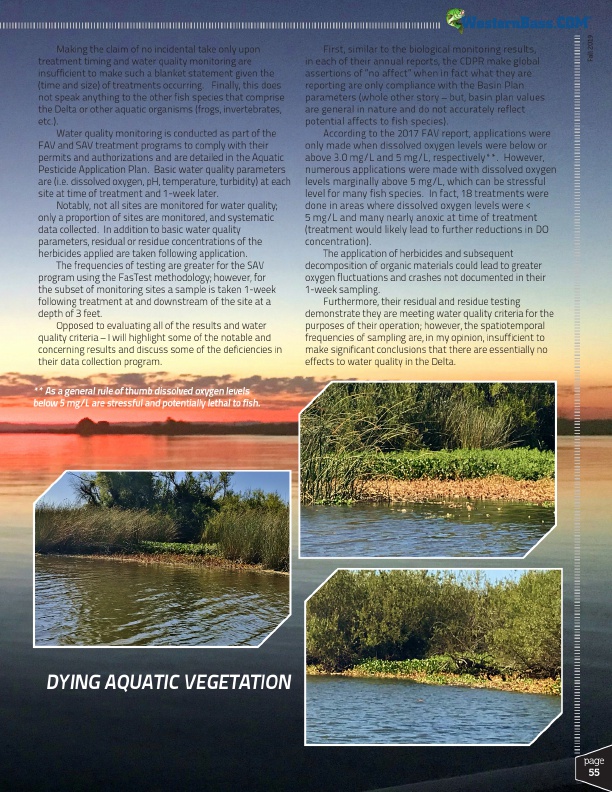
Fall 2019
Making the claim of no incidental take only upon treatment timing and water quality monitoring are insufficient to make such a blanket statement given the (time and size) of treatments occurring. Finally, this does not speak anything to the other fish species that comprise the Delta or other aquatic organisms (frogs, invertebrates, etc.).
Water quality monitoring is conducted as part of the FAV and SAV treatment programs to comply with their permits and authorizations and are detailed in the Aquatic Pesticide Application Plan. Basic water quality parameters are (i.e. dissolved oxygen, pH, temperature, turbidity) at each site at time of treatment and 1-week later.
Notably, not all sites are monitored for water quality; only a proportion of sites are monitored, and systematic data collected. In addition to basic water quality parameters, residual or residue concentrations of the herbicides applied are taken following application.
The frequencies of testing are greater for the SAV program using the FasTest methodology; however, for the subset of monitoring sites a sample is taken 1-week following treatment at and downstream of the site at a depth of 3 feet.
Opposed to evaluating all of the results and water quality criteria – I will highlight some of the notable and concerning results and discuss some of the deficiencies in their data collection program.
First, similar to the biological monitoring results, in each of their annual reports, the CDPR make global assertions of “no affect” when in fact what they are reporting are only compliance with the Basin Plan parameters (whole other story – but, basin plan values are general in nature and do not accurately reflect potential affects to fish species).
According to the 2017 FAV report, applications were only made when dissolved oxygen levels were below or above 3.0 mg/L and 5 mg/L, respectively**. However, numerous applications were made with dissolved oxygen levels marginally above 5 mg/L, which can be stressful level for many fish species. In fact, 18 treatments were done in areas where dissolved oxygen levels were < 5 mg/L and many nearly anoxic at time of treatment (treatment would likely lead to further reductions in DO concentration).
The application of herbicides and subsequent decomposition of organic materials could lead to greater oxygen fluctuations and crashes not documented in their 1-week sampling.
Furthermore, their residual and residue testing demonstrate they are meeting water quality criteria for the purposes of their operation; however, the spatiotemporal frequencies of sampling are, in my opinion, insufficient to make significant conclusions that there are essentially no effects to water quality in the Delta.
** As a general rule of thumb dissolved oxygen levels below 5 mg/L are stressful and potentially lethal to fish.
®
DYING AQUATIC VEGETATION
page 55